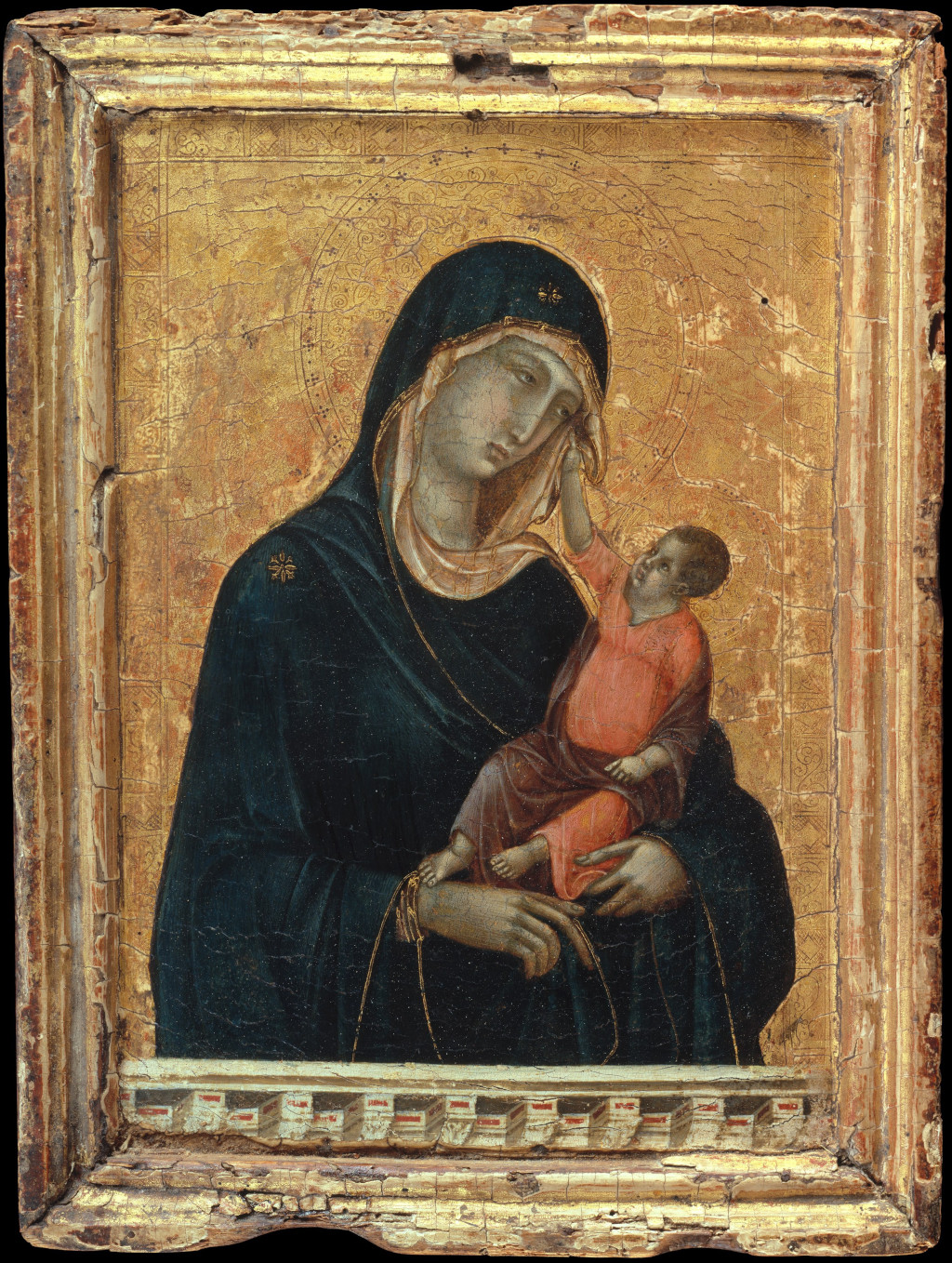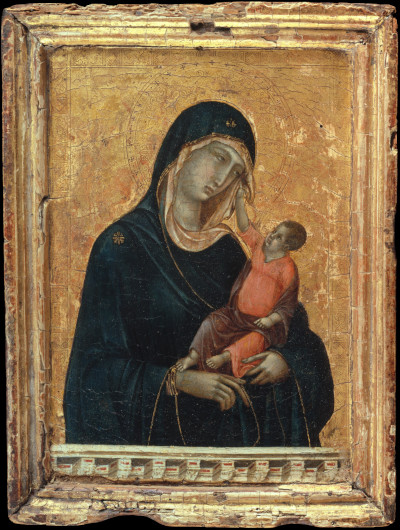This piece, dated to around circa 1300, is one of Duccio di Buoninsegna's most famous depictions of the Madonna and Child. He was from Siena, an Italian city which became particularly well known for its use of this iconic imagery.
The Proto Renaissance was an important artistic period in which the Byzantine artistic styles were moved away from, towards the developments of the main periods of the Renaissance. This would ultimately impact everything - from literature, to architecture, and most especially sculpture and painting. Duccio, Giotto and Cimabue were critical contributions to this evolution, and the Madonna and Child would be one of the most common sights within their careers. Even just Duccio himself would re-visit this theme many times across his career, though we are only aware of this because of how well documented his oeuvre is, as compared to other major names from the 13th and 14th century. Even the great Giotto, for example, has very few artworks which are conclusively known to be his, with a large number labelled as "attributed to" or "from the workshop of". Alongside the artwork found in this page, Duccio's most famous paintings would have to be Rucellai Madonna and Maestà, both of which feature much the same focal point.
Siena developed a respected art school which was prominent between the 13th and 15th century. It was perhaps most famous for its depictions of the Madonna and Child, and so many donors from elsewhere with a desire for this type of content would select Sienese artists to complete their commissions. Duccio was very much at the forefront of this school and would teach many students himself, some of whom would later build solid careers of their own. Duccio himself is attributed to a whole host of different depictions of the Madonna and Child, becoming somewhat of a specialist in this imagery. It is hard to say whether he chose to re-visit this topic so frequently, or did so at the request of a steady stream of powerful patrons. He would surely have appreciated the opportunities brought to any artist by this emotional and powerful scene that provided many with a strength of faith and hop for the future.
Duccio kept himself busy throughout his lifetime and worked right across the region of Tuscany. He is known to have accrued considerable debts and so was forced to accept commissions regularly in order to offset some of his own expenditure. He had a large family, and was common for the time, and so had to maximise his considerable reputation as one of the most skilled artists in Italy at that time. His achievements went a considerable way in establishing the Siena School which continued successfully for two centuries after his passing. Duccio is also regularly featured within art history studies, because of how he helped to move Italy towards the main part of the Renaissance, which itself would influence the direction of art right across the western world in the centuries that followed. Normally, these discussions also include Cimabue and Giotto, whose careers are closely linked in terms of style, content and impact.
Table of Contents
- Description of the Painting
- Artistic Techniques used by Duccio
- History of the Artwork
- Where can the Madonna and Child be found Today?
- What Paintings are Displayed alongside this Piece at The Met?
- What other Paintings of the Madonna and Child did Duccio Produce?
- What other Artworks did Duccio Produce around this time?
- Large Image of Duccio's Madonna and Child
Description of the Painting
Working from a relatively small panel, the artist chooses to keep this composition relatively simple. Just the Madonna and Child are included, with the background filled entirely with the golden tone which can be found throughout the career of Duccio. The colours used here are typical of the imagery, with the Madonna in a dark blue cape, and the young baby dressed in pink. Normally the Madonna would also have a red dress underneath, but the artist chooses not to include that within this painting. Duccio also cuts the scene off at around her waist, allowing more detail on the uppper half and particularly the facial features. Mother and Child look directly into each other's eyes, underlining the importance and strength of their bond. The child reaches out a hand playfully, whilst he is held tightly by her two hands, and lent onto her left arm. The original frame remains in use today, but has naturally picked up considerable wear and tear over the centuries that have passed since.
Artistic Techniques used by Duccio
We can see the direct influence of Byzantine art in several elements of this painting. The long, extended nose, and oval shaped head are typical of this movement. The child is also particularly small in relation to his mother and that was another common feature of the Byzantine approach. Other elements to this painting, though, show an evolution towards the later styles of the Renaissance. We feel a strong emotional connection between the two figures, for example, as they stare fondly at each other. There is also a feature of sculptured architecture that is painted across the bottom of the painting, which is a modern idea, though most viewers do not notice this feature because of how it can visually merge into the frame that surrounds the piece. Painted architecture would also become a common technique within North European art. The combination of styles within Duccio's Madonna and Child have allowed historians to loosely date the piece at around circa 1300, taking into consideration how his style evolved across his lifetime.
History of the Artwork
The history of this piece is only documented from the mid 19th century, and so it has taken some time for the correct attribution to be found. It would eventually be purchased by the current owners, The Metropolitan Museum of Art, in 2004 for a price rumoured to have been around $45m. The high price is representative of the significance of this piece, and Duccio's career more widely. It is also extremely rare for an American institution to even get the opportunity to acquire an artwork such as this, and its attributes also made it a good fit with the musuem's existing collection. Typically, purchases such as this will be made with a combination of funds from private and public sources, who all share the understanding of the importance of protecting and building upon one's cultural resources. The piece was originally owned by Russian Count Gregori Stroganoff (some still refer to the piece as the Stroganoff Madonna) when it first came onto the radar of art historians and then changed hands several times before arriving at its present location in the US.
Where can the Madonna and Child be found Today?
This important artwork from the Proto Renaissance can be found at the Metropolitan Museum of Art in New York, USA. They themselves actually date the piece more loosely at around circa 1290-1300 and would have had the resources to carry out considerable research on this piece. This important institution is believed to have acquired the piece as recently as 2004, when previously it was part of a private collection. They have revealed that the current frame used is actually the original one as agreed by the donor and artist all those centuries ago. The piece was also an independent commission, and unrelated to any other work by the artist, where as some other items from his career to be found within the US are actually fragments or individual panels from a larger project that was later dismantled, such as the Siena Altarpiece. The size of this artwork, with it being relatively small, means it is likely to have been used as a devotional piece.
What Paintings are Displayed alongside this Piece at The Met?
This important piece by Duccio is to be found, at the time of writing, in the The Met Fifth Avenue, Gallery 624. The room itself is titled, "Giotto's Legacy: 1230–1450", which gives one a good idea of the type of pieces to be found within it. Giotto's Adoration of the Magi can be found here, as can Saint Alexander by Fra Angelico. Saint Lawrence Enthroned with Saints and Donors by Fra Filippo Lippi from the 1440s is also often featured within this display, alongside a large number of other tempera on panel pieces from significant, but slightly less famous artists. It is a stunning selection and a rarity within the US, with most artworks from this period remaining in Europe. The nature of tempera on panel, as opposed to fresco techniques, does mean that the opportunity to move these artworks is much more of a possibility than with designs placed directly into plastered walls.
What other Paintings of the Madonna and Child did Duccio Produce?
The iconic imagery of the Mother and Child would appear many times within Duccio's oeuvre. Rucellai Madonna and Maestà are certainly the most famous of those, with other important contributions including the likes of the Crevole Madonna, Madonna with Child and Six Angels and Gualino Madonna. Most of these interpretations feature fairly simple compositions, with little detail included other than the two figures. He would typically cover the background with gold paint and then just add a few variations to make each piece unique. For example, the artwork in front of us here has the marble sculptured wall which covers the foot of the artwork but is not seen elsewhere. Besides these smaller, independent pieces, there were also more ambitious commissions, such as Madonna and Child with Saints Polyptych and Madonna and Child on a Throne, in which a complex design of wooden panels would have additional artworks alongside the main content.
What other Artworks did Duccio Produce around this time?
Assuming the approximate date on this piece of around 1290-1300 to be correct, there were some other important paintings to come from Duccio at around the same time as Madonna and Child. Madonna and Child with Saints from the Pinacoteca Nazionale is dated at exactly the turn of the century, for example, and several years later was Duccio's Maestà, featuring a two sided design for an altarpiece. There was also the The Nativity with the Prophets Isaiah and Ezekiel at around that time as well. Duccio did not go far from the boundaries of Tuscany too often, which makes it harder to order these artworks particularly accurately. Other notable artists would move around the country and then each artwork could be placed within a timeline based around their specific movements from one city to the next. Some of the issues around attribution that surrounds most of the artists from the Proto Renaissance has also made the task of creating accurate timelines more difficult.
Large Image of Duccio's Madonna and Child





